What is found in all prokaryotic organisms Study guides, Class notes & Summaries
Looking for the best study guides, study notes and summaries about What is found in all prokaryotic organisms? On this page you'll find 1100 study documents about What is found in all prokaryotic organisms.
Page 3 out of 1.100 results
Sort by
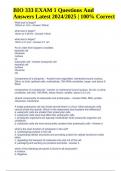
-
BIO 333 EXAM 1 Questions And Answers Latest 2024/2025 (100% Correct)
- Exam (elaborations) • 14 pages • 2024
-
- $16.99
- + learn more
BIO 333 EXAM 1 Questions And Answers Latest 2024/2025 (100% Correct) What size is larger? 100um or 1nm - Answer 100um what size is larger? 10mm or 0.001m - Answer 10mm what size is larger? 10nm or 0.1um - Answer 0.1 um Put in order from largest to smallest. bacterial cell ribosome nucleus o2 eukaryotic cell - Answer eukaryotic cell bacterial cell nucleus ribosome O2 Components of a eukayote. - Answer have organelles, membrane bound nucleus, 24hrs. to divid, epitheal cells, multi...
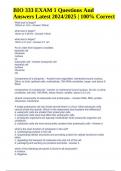
-
BIO 333 EXAM 1 Questions And Answers Latest 2024/2025 | 100% Correct
- Exam (elaborations) • 14 pages • 2024
-
- $15.49
- + learn more
BIO 333 EXAM 1 Questions And Answers Latest 2024/2025 | 100% Correct. What size is larger? 100um or 1nm - Answer 100um what size is larger? 10mm or 0.001m - Answer 10mm what size is larger? 10nm or 0.1um - Answer 0.1 um Put in order from largest to smallest. bacterial cell ribosome nucleus o2 eukaryotic cell - Answer eukaryotic cell bacterial cell nucleus ribosome O2 Components of a eukayote. - Answer have organelles, membrane bound nucleus, 24hrs. to divid, epitheal cells, mult...
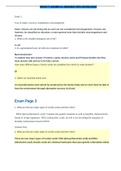
-
BIOD171 EXAMS A+ GRADED 100% RATED-2022
- Exam (elaborations) • 34 pages • 2022
-
- $11.49
- 1x sold
- + learn more
True or False: A virus is considered a microorganism. False. Viruses are not living and as such are not considered microorganisms. Viruses can, however, be classified as microbes, a more general term that includes microorganisms and viruses. 2. What is the smallest biological unit of life? A cell. 3. At a generalized level, all cells are comprised of what? Macromolecules* *A student may also answer: Proteins, Lipids, Nucleic acids and Polysaccharides but they must answer with all four t...
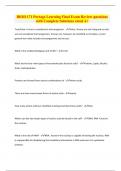
-
BIOD 171 Portage Learning Final Exam Review questions with Complete Solutions rated A+
- Exam (elaborations) • 25 pages • 2024
-
- $11.49
- + learn more
True/False. A virus is considered a microorganism. - False, Viruses are not living and as such are not considered microorganisms. Viruses can, however, be classified as microbes, a more general term that includes microorganisms and viruses. What is the smallest biological unit of life? - A cell What are the four main types of macromolecules found in cells? - Proteins, Lipids, Nucleic Acids, Carbohydrates Proteins are formed from various combinations of - Amino acids There are how many kno...
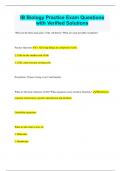
-
IB Biology Practice Exam Questions with Verified Solutions
- Exam (elaborations) • 8 pages • 2024
-
- $9.99
- + learn more
IB Biology Practice Exam Questions with Verified Solutions What are the three main parts of the cell theory? What are some possible exceptions? Practice Question 1. All living things are composed of cells. 2. Cells are the smallest unit of life 3. Cells come from pre-existing cells Exceptions: Viruses: living or not? and amoeba What are the basic functions of life? What organisms carry out these functions? Metabolism, response, homeostasis, growth, reproduction and nutrition....
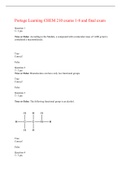
-
Portage Learning CHEM 210 exams 1-8 and final exam
- Exam (elaborations) • 124 pages • 2022
-
- $18.49
- 5x sold
- + learn more
Portage Learning CHEM 210 exams 1-8 and final exam Question 1 3 / 3 pts True or False: According to the Module, a compound with a molecular mass of 1,000 g/mol is considered a macromolecule. True Correct! False Question 2 3 / 3 pts True or False: Biomolecules can have only two functional groups. True Correct! False Question 3 3 / 3 pts True or False: The following functional group is an alcohol. True Correct! False Question 4 3 / 3 pts True or False: In ...
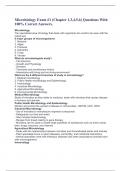
-
Microbiology Exam #1 (Chapter 1,3,4,5,6) Questions With 100% Correct Answers.
- Exam (elaborations) • 23 pages • 2024
-
- $15.99
- + learn more
Microbiology Exam #1 (Chapter 1,3,4,5,6) Questions With 100% Correct Answers. Microbiology The specialized area of biology that deals with organisms too small to be seen with the naked eye 6 major groups of microorganisms 1. Bacteria 2. Algae 3. Protozoa 4. Helminths 5. Fungi 6. Viruses What do microbiologists study? - Cell structure - Growth and Physiology - Genetics - Taxonomy and evolutionary history - Interactions with living and non living environment What are the 6 differ...
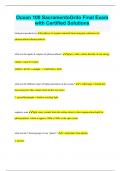
-
Ocean 100 SacramentoGrilo Final Exam with Certified Solutions
- Exam (elaborations) • 16 pages • 2024
- Available in package deal
-
- $9.99
- + learn more
Ocean 100 SacramentoGrilo Final Exam with Certified Solutions biological productivity synthesis of organic materials from inorganic substances by photosynthesis/chemosynthesis what are the inputs & outputs of photosynthesis? inputs: water, carbon dioxide, & sun energy outputs: sugar & oxygen (6H2O + 6CO2 + sunlight - > C6H12O6 + 6O2) what are the different types of light penetration in the oceans? 1. red/orange = turned into heat energy b/c they cannot reach all the way down ...
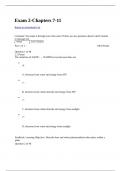
-
BIOL133 Exam 2 CH7-11 American Public University
- Exam (elaborations) • 29 pages • 2023
-
- $18.99
- + learn more
BIOL133 Exam 2 CH7-11 American Public University Question 1 of 40 2.5 Points The reduction of NADP+ → NADPH occurs because there are A. electrons from water and energy from ATP B. electrons from carbon dioxide and energy from ATP C. electrons from carbon dioxide and energy from sunlight D. electrons from water and energy from sunlight Feedback: Learning Objective: Describe how and where photosynthesis takes place within a plant Question 2 of 40 664306 Exam 2-Chap...
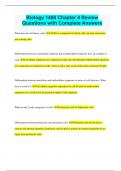
-
Biology 1406 Chapter 4 Review Questions with Complete Answers
- Exam (elaborations) • 8 pages • 2024
- Available in package deal
-
- $9.99
- + learn more
Biology 1406 Chapter 4 Review Questions with Complete Answers What does the cell theory state? All life is composed of cells & cells can only come from pre-existing cells. Differentiate between a unicellular organism and a multicellular organism, give an example of each. Unicellular organisms are composed of only one cell; Bacteria; Multicellular oganisms are composed of a multitude of cells, where a cell is only a part of the entire organism; People. Differentiate between unicellul...

How much did you already spend on Stuvia? Imagine there are plenty more of you out there paying for study notes, but this time YOU are the seller. Ka-ching! Discover all about earning on Stuvia


